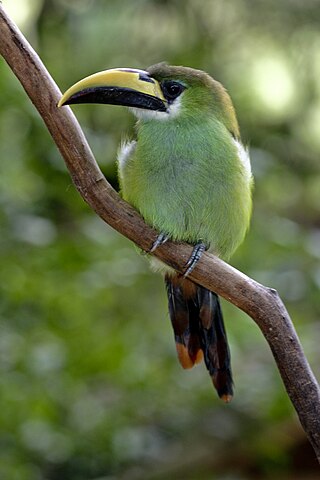
The emerald toucanet is a species of near-passerine bird in the toucan family Ramphastidae. It is found from Mexico to Nicaragua.

The blue-throated toucanet is a near-passerine bird in the toucan family Ramphastidae. It is found in Costa Rica, Panama and far northwestern Colombia.

The collared aracari or collared araçari is a near-passerine bird in the toucan family Ramphastidae. It is found from Mexico to Colombia and Venezuela.

Ramphastos is a genus of toucans, tropical and subtropical near passerine birds from Mexico, and Central and South America, which are brightly marked and have enormous, often colourful, bills.

An aracari or araçari is any of the medium-sized toucans that, together with the saffron toucanet, make up the genus Pteroglossus.
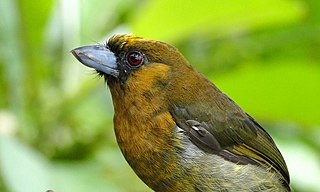
The prong-billed barbet is a distinctive, relatively large-billed bird native to humid highland forest of Costa Rica and western Panama.
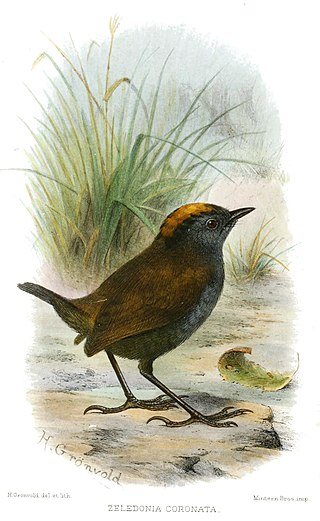
The wrenthrush or zeledonia is a unique species of nine-primaried oscine bird which is endemic to Costa Rica and Panama.

The chestnut-eared aracari or chestnut-eared araçari is a near-passerine bird in the toucan family Ramphastidae. It is found in Argentina, Bolivia, Brazil, Colombia, Ecuador, Paraguay, and Peru.

The groove-billed toucanet is a near-passerine bird in the toucan family Ramphastidae. It is found in Colombia and Venezuela.
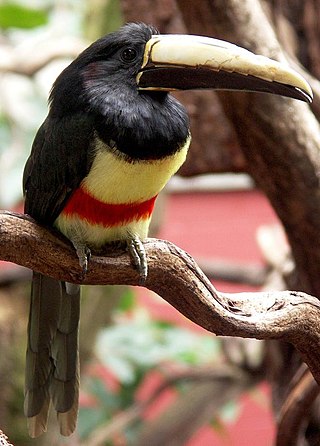
The black-necked aracari or black-necked araçari is a near-passerine bird in the toucan family Ramphastidae. It is found in Brazil, French Guiana, Guyana, Suriname, and Venezuela.

The ivory-billed aracari or ivory-billed araçari is a near-passerine bird in the toucan family Ramphastidae.. It is found in Brazil, Colombia, Ecuador, Peru, and Venezuela.

The curl-crested araçari or curl-crested araçari is a near-passerine bird in the toucan family Ramphastidae. It is found in Bolivia, Brazil, and Peru.
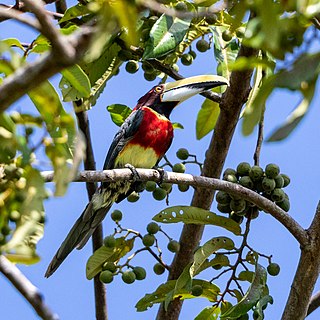
The red-necked aracari or red-necked araçari is a near-passerine bird in the toucan family Ramphastidae. It is found in Bolivia and Brazil.

The pale-mandibled aracari or pale-billed araçari is a near-passerine bird in the toucan family Ramphastidae. It is found in Ecuador and Peru.

The lettered aracari or lettered araçari is a near-passerine bird in the toucan family Ramphastidae. It is found in Bolivia, Brazil, Colombia, Ecuador, and Peru.

The brown-mandibled aracari is a near-passerine bird in the toucan family Ramphastidae.. It is found in Bolivia, Brazil, and Peru.

The many-banded aracari or many-banded araçari is a near-passerine bird in the toucan family Ramphastidae. It is found in Brazil, Colombia, Ecuador, Peru, and Venezuela.

The stripe-billed aracari or stripe-billed araçari is a near-passerine bird in the toucan family Ramphastidae. It is found in Colombia, Ecuador, and Panama.
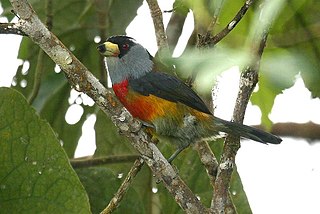
The toucan-barbets are the small bird genus Semnornis. This was often included in the paraphyletic barbets but recently usually considered a distinct family Semnornithidae; alternatively, all barbets might be moved to the toucan family Ramphastidae as a subfamily, Semnornithinae. It contains only two species, the toucan barbet and the prong-billed barbet.

Wagler's toucanet is a species of bird in the toucan family Ramphastidae. It is endemic to southwestern Mexico.























